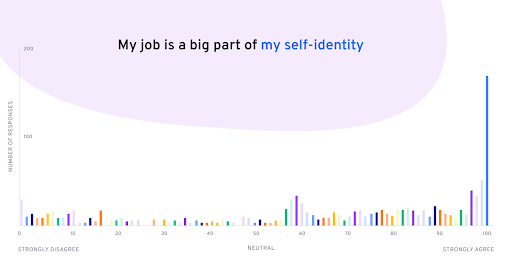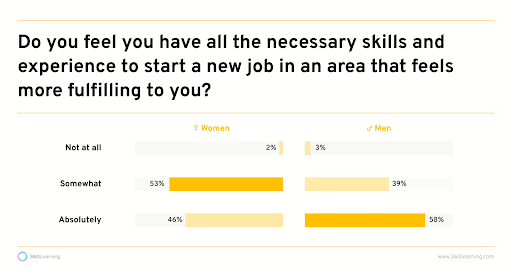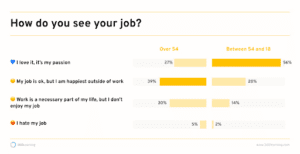As COVID-19 restrictions continue to ease in many parts of the world, some employers might be tempted to think that work is starting to go “back to normal.” However, while Americans might be traveling, socializing and coming back into the office more often, the Great Resignation — or, as we like to think of it at 360Learning, the Great Rethink — has left its mark. Far from returning to the pre-pandemic status quo, employees have proven they’re unwilling to stay in jobs where they feel underpaid, burnt out and unfulfilled.
So, what can L&D teams do to create workplaces employees don’t want to quit? How can they answer the specific needs of different cohorts? Our survey of more than 1,000 American workers helped us unravel what still requires fixing in the workplaces of 2022.
To support companies in creating work environments employees will thrive in, our strategies are based on the insights of fellow learning and development leaders that L&D departments, HR professionals and leadership teams can rely on to build the workplaces today’s employees demand.
Empower employees to grow through career pathways, internal mobility and mentorship
One of the key learnings from our survey is just how important work is to most Americans. Far from wanting to give up their jobs, what employees really want is work they find rewarding, with commensurate compensation.

Most Americans think their job is important to their self-identity, and, in fact, the pandemic actually made just over half of them feel their work was more important to them, according to our survey. But employees who don’t find their job fulfilling will quit; “unfulfilling work” was tied for the second most-cited reason from the respondents in our survey who said they had left their jobs, or were considering it.

One of the tools companies have at their disposal — internal mobility — was unfortunately underutilized as an employee retention strategy; internal mobility wasn’t an option for just under half of our respondents, and almost a third didn’t even bother asking for fear of being turned down. This is a shame, since roughly half of our respondents feel a promotion is the only way to learn new skills at work.

L&D teams should feel empowered with strategies to retain talent, and help employees grow, develop, or change roles to align their work with their aspirations. Here are three actionable strategies the companies 360Learning, Animalz and Opendoor are using to show employees that L&D is a priority:
- Build a clear career path so employees know exactly where they’re going at your company (360Learning).
- Enable and embrace internal mobility so you don’t lose talented employees that need a change of pace to follow a more fulfilling career trajectory (Animalz).
- Create a peer mentoring program to enable continuous learning, even in a fast-paced environment (Opendoor).
By laying out clear pathways for career development, whether that means moving into a management role, specializing in a certain area, or making a lateral role change, you increase the possibility that your employees will continue to find their work engaging and rewarding.
Ensure you level the playing field for women in the workplace
It’s important to remember that not all employees have the same experience on the job, and that these differences were often exacerbated during the pandemic. Gender is one factor among many that shapes workplace challenges, and our research bore this out.
Firstly, women seem to lack confidence when it comes to internal mobility or career changes. Of those who recently quit their jobs (or are considering it), women are less likely than men to ask about internal mobility, either because they didn’t think their employer would give them what they wanted (31 percent versus 20 percent), or because it wouldn’t have made them want to stay (28 percent versus 15 percent). Men are also more likely (58 percent) to say they “absolutely” have the necessary skills to succeed in a job they find more fulfilling, whereas women mostly say they “somewhat” do (53 percent).

Women also seemed to bear the brunt of workplace stress. Of the respondents to our survey who quit because of burnout, 72 percent were women. Indeed, while men’s clear preference for why they quit was low salary, for women, burnout and low salary were tied. Finally, for those who said they didn’t feel fulfilled in their job, women were much more likely to say it was because their work wasn’t valued. For men, it was because there was no room for career development — their work not being valued was the second least chosen response.

Although great strides have been made in recent years, women still face unique obstacles when it comes to their careers. Here are some ways L&D teams can work with HR and leadership to help ensure women have an equitable experience at work:
- Anti-bias training, to address implicit bias in hiring and promotions, to help fix “the broken rung” when it comes to women, and especially women of color, in management and leadership roles.
- Make compensation, performance review and promotion figures publicly available, so anyone can call out bias or favoritism.
- Institute coaching for women, like 360Learning is doing with their women @ 360 program with MoovOne by CoachHub, to help ensure gender parity in leadership positions.
Without commitments from L&D, HR, and leadership teams towards transparency, coaching and appropriate employee training, it will be difficult to make equitable workplaces the norm.
Don’t lose the skills of the baby boomer generation to stagnation and ‘bore out’
Another demographic that was particularly affected by the pandemic were baby boomers. The Great Resignation saw many older employees retire early instead of staying in jobs they didn’t like or found unsafe. This is certainly the picture painted by our respondents over the age of 54 — undervalued and overworked, this cohort doesn’t feel passionate about their job.

Firstly, our study found that older respondents felt less fulfilled and less passionate about their work overall. While 18 to 54-year-olds had a median score of 87 when asked how fulfilled they felt at work, over 54-year-olds scored only 77. Similarly, they were more likely to say that their job was just, “OK,” as opposed to younger cohorts who said, “I love it, it’s my passion.”

Baby boomers were also markedly less likely to see their job as a big part of their self-identity, as opposed to the younger generations in our survey, with scores of 55 versus 82, respectively. This lack of enthusiasm might stem from how they believe their work is perceived; for those who said they didn’t feel fulfilled at work, most over the age of 54 said it was because either their work wasn’t valued (or there was no room for development), while younger respondents said it was because their work was boring.

When experienced employees drop out of the workforce, everybody loses — workers don’t feel appreciated, and teams lose valuable institutional knowledge. L&D teams can help engage older workers and encourage them to stick around through:
- Collaborative learning. Asking baby boomers to share their institutional knowledge with younger colleagues might make them feel more valued, while at the same time ensuring younger peers continue to learn. It also means valuable knowledge doesn’t leave your organization once an employee retires.
- Taking a bottom-up approach to learning needs. Go directly to the source and ask baby boomers what they want to be learning, so they don’t feel their career development is at an impasse.
Building workplaces employees will thrive in
What lessons can we say we’ve learned from the Great Resignation? L&D teams need to make it easier for employees to find meaning in their jobs — if not, they’ll walk. Women continue to struggle to climb the career ladder at the same pace as men. And, baby boomers feel disengaged and are tempted by early retirement.
For all of these issues, L&D teams have steps they can take, from setting up coaching and mentoring programs to anti-bias training to encouraging knowledge sharing through collaborative learning. Hopefully, L&D leaders can use these learnings to build better workplaces to attract and retain talent as employees continue to rethink their relationship with work.















